“All new words are created because a new sound is needed to voice an idea, usually also new.”
—Charles Wolverton
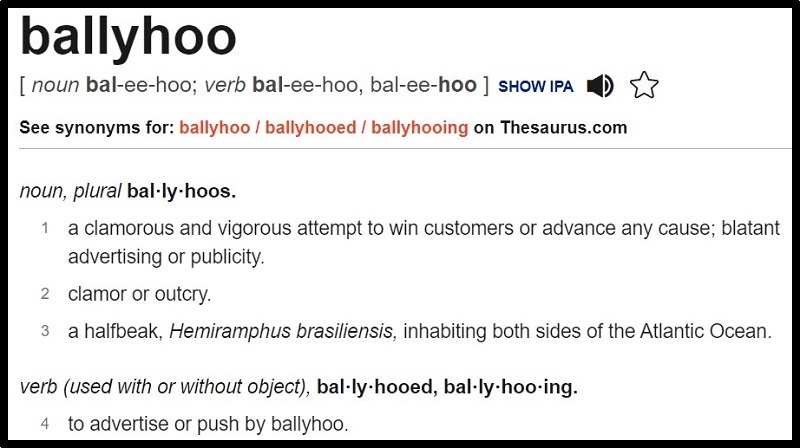
The word ballyhoo, according to the renowned and authoritative Oxford English Dictionary (OED), means a “a showman’s touting speech, or a performance advertising a show.” It can be used as a mass noun to mean “bombastic nonsense; extravagant or brash publicity; noisy fuss.” Though this “carnival” usage has uncertain origins, the OED and other etymology sources cite the first known examples as coming from the early 1900s.
Or, did ballyhoo originate on the Midway Plaisance at the 1893 World’s Columbian Exposition in Chicago?
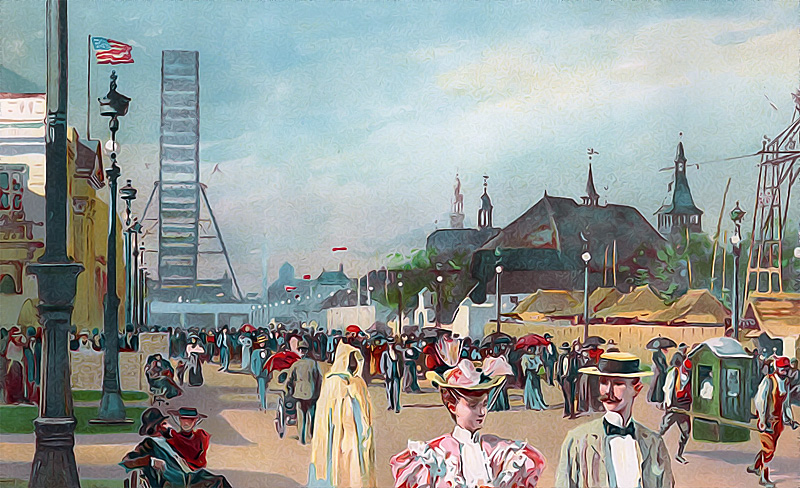
The Midway Plaisance by T. de Thulstrup. [Image from Burnham, Daniel Hudson; Millet, Francis Davis The Book of the Builders Vol 1. No 3, May 5, 1894.]
Diabolical definitions
Tracing the roots of ballyhoo, like so many American English words, is challenging because there are several different meanings with separate etymologies. The origin of the “noisy fuss” of the Midway Plaisance needs to be distinguished from some other meanings of ballyhoo.
Dating to much earlier times was its usage as a noun meaning “Hell” and its gerund “to raise hell: to cause great trouble; to create chaos.” The origin of this meaning perhaps is derived from the town of Ballyhoo in Ireland.
At the time of the 1893 World’s Fair, this “raising hell” usage remained common. Newspapers in the 1880–95 range include stories describing someone “being drunk and raising ballyhoo,” a boy who “caught ballyhoo” from his father and another afraid that his mother would “give him ballyhoo.” The subject of one article would “kick up ballyhoo,” another would “raise ballyhoo,” and a third thought that “the country can go to ballyhoo.” In all these cases, the meaning of ballyhoo is consistent with the “hellish” definition.
The OED also lists another older use of ballyhoo to mean “a vessel which is worn out, slovenly, run-down, or otherwise disliked.” Herman Melville used this meaning in a line of dialog in his 1847 novel Omoo: A Narrative of Adventures in the South Seas: “Be off wid ye thin, darlints, and steer clear of the likes of this ballyhoo of blazes as long as ye live” This nautical slang term, though, seems to have become obsolete by 1893.
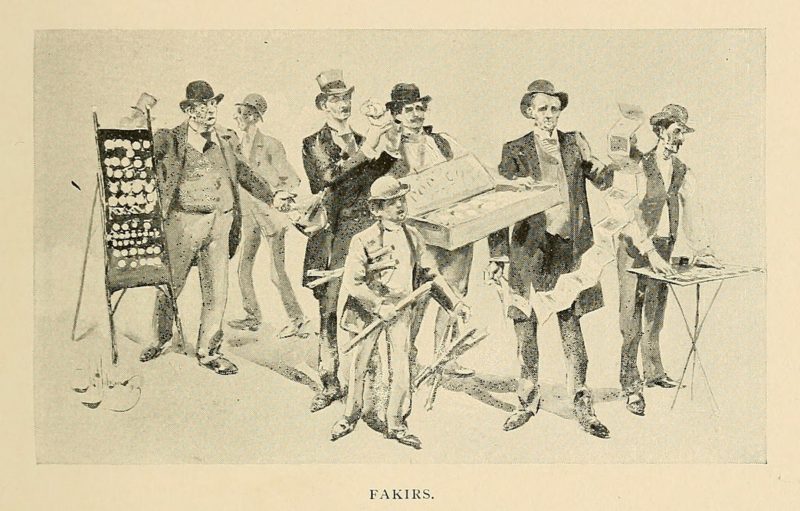
“Fakirs” selling their wares. [Image from Millet, F. D. et al. Some Artists at the Fair. Charles Scribner’s Sons, 1893.]
Midway Slanguage
A few word sleuths and historians—seemingly unknown or dismissed by the OED—have traced the origin of “showman’s touting speech” definition to the Midway Plaisance of the 1893 World’s Fair, where barkers (“fakirs”) shouted ballyhoo!
“A resume of the origin of the carnival as we now know it, must necessarily begin with the World’s Columbian Exposition at Chicago in 1893,” writes W. O. Taylor in a 1934 history of carnivals, “at which was born the idea of taking the salient features of its mighty midway to the millions who had heard of but had not seen the ‘Highway of All Nations.’” Taylor records the emergence of several slang terms from the Midway Plaisance, including “spieler,” “grinder,” “opener,” “doorman,” “barker,” and a new meaning for ballyhoo:
“It was at Chicago that a number of words long since in use were formed and given meanings. The word ‘ballyhoo’ being the keynote of the carnival business was one of the first to be used on the midway. It came from Asia, and has long been used by the Mohammedan dervishes as a catch phrase to shout when they had nothing else to say. As the dervishes are a kind of an Oriental salvation army, they gather on street corners to make a stand and take up a collection. At such times they shout ‘B’ Allah Hoo,’ meaning ‘Thou Art God.” Then it was only a short step to say that Americans ‘make ballyhoo’ when they create a noise to attract a crowd. Later the word was given numerous shades of meaning, all having to do with attracting a standing audience.”
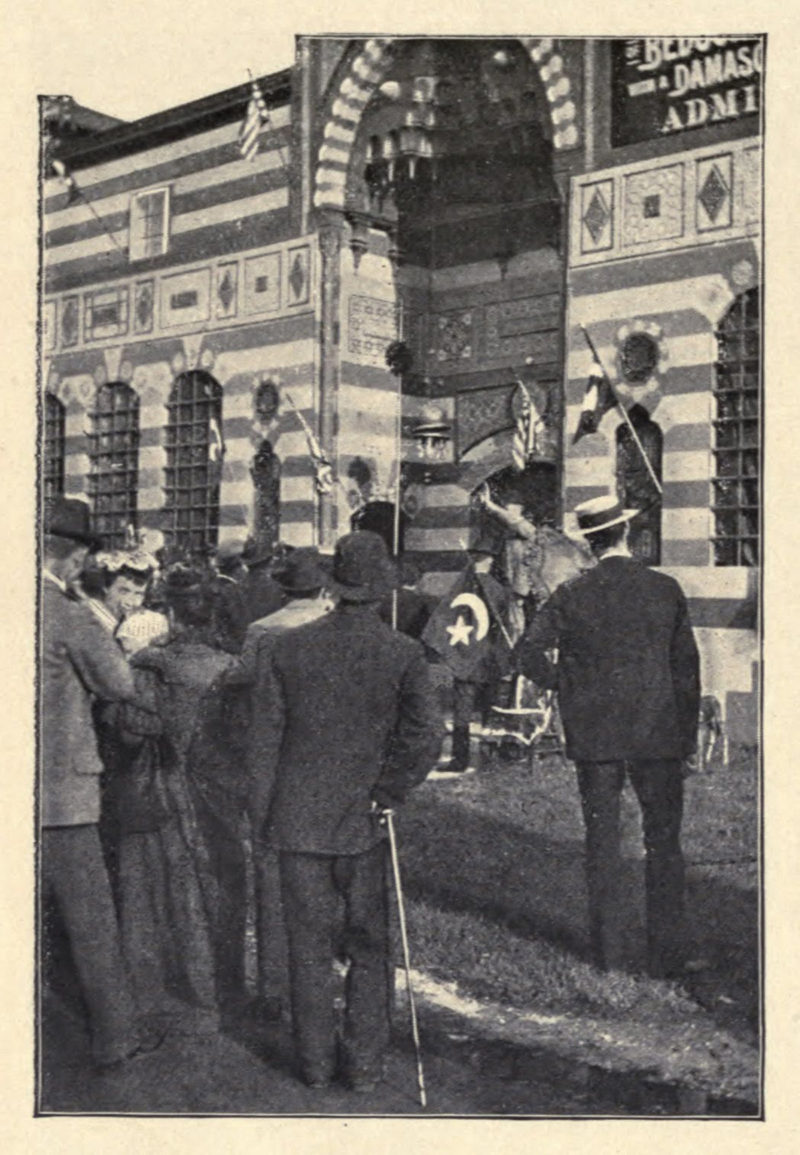
The entrance to the Turkish Village on the Midway, showing a spieler enticing the crowd to enter. [Image from Cosmopolitan Magazine, Sept. 1893.]
Make B’Allah hoo
Chicago newspaper man Charles Wolverton read Taylor’s recollection of the Midway and was intrigued by the alleged origin of ballyhoo to the Sufi chant “Allah Hoo.” To learn more about the neologism allegedly born at the 1893 World’s Fair, he tracked down Taylor, who was working in Ohio for the Archbold Buckeye newspaper that he founded in 1905 (and still in existence). Wolverton published what he learned from Taylor in the December 1935 issue of the journal American Speech, citing his “gratification in being able to find the actual American who, forty-two years ago, brought that rich and gorgeous word, ballyhoo, into the speech of our people.” Taylor shared that he had worked as a “press agent, teacher of American mannerisms, spieler and general advisor” at the Turkish Theatre (also called the Oriental Odeon theatre), part of the Turkish Village on the Midway.
“We had two Mohammedan dervishes. These two appeared on the stage of the Turkish Theatre, doing their dervish whirling, dancing and howling …, but it did not go over with the box office. Because I discounted their act they were peeved. To be avenged they came out in their costumes and did their act in front. … Their act began with a jumping and dashing about and shouting ‘B’Allah hoo.’ This phrase they repeated in tones ever threatening and appealing. The result was that they did what I had been wanting done; they collected a great crowd in front, which gave me a chance to make a spiel and sell the inside show to the multitude. When I had finished my talk the Turkish Theatre received the largest crowd it ever had had.”
Having turned around the fortunes of the act, they asked Mr. Taylor to come out front again and “make B’Allah hoo.” Ballyhoo was born. Other showmen along the Midway quickly adopted the new term to solicit business for their attractions.
The Turks told Mr. Taylor that the phrase they uttered meant “thou art God,” reports Wolverton, but a Persian scholar surmised:
“The first a in Allah is attacked so sharply by a percussive action deep in the throat, that the letter sounds as though a consonant preceded it. So it was easy for Mr. Taylor to hear a b in this strange and reverent oath.”
H. L. Mencken included Wolverton’s ballyhoo origin story in his fourth edition of American Language (1937). Summarizing Wolverton’s findings, Motion Picture Herald noted that “Mr. Taylor will no doubt be glad to know that after all these years, the jumping, shouting and dashing about is still used to build up the bally.”
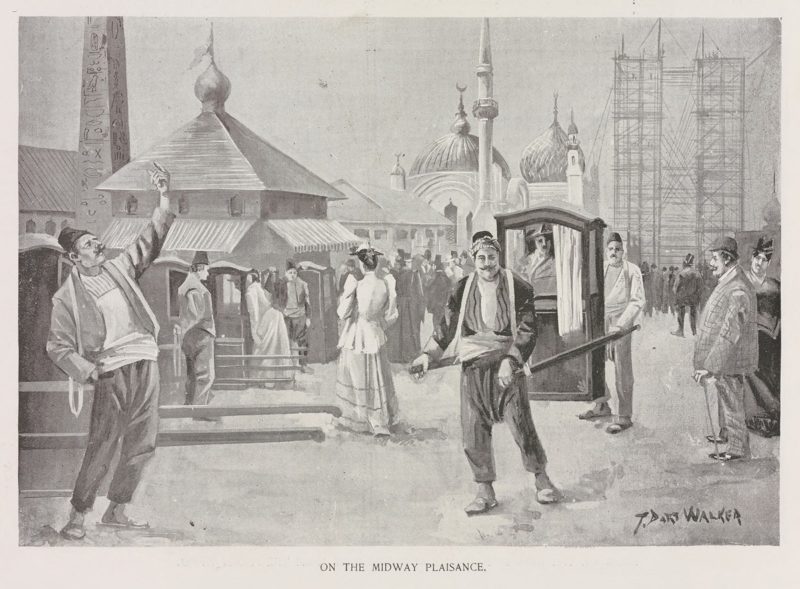
“On the Midway Plaisance” depicts a spieler in front of the Turkish Theatre, on the left with the Ferris Wheel still under construction in the background. [Image from The Graphic History of the Fair. Graphic Co., 1894.]
“Come here”
A different version of the ballyhoo origin comes from carnival historian Joe McKennon in his study A Pictorial History of the American Carnival. He attributes this alternate explanation of the word origin to “a long-time carnival showman” named Jean DeKreko, who also worked on the Midway of the 1893 Fair:
“All talkers had to use interpreters in order to communicate with the people on their next attraction. All of the Middle Easterners used Arabic as a common language. A spieler would tell the interpreter to get the performers out front to attract a crowd. The interpreter would yell back to the attraction’s personnel, ‘Dehalla Hoon,’ an Arabic word meaning ‘Come here.’ If the interpreter was away and the talker wanted his people out front, he used that word himself. He pronounced it a little differently, though. To his Western ear it sounded like ‘Ballyhoo.’ All outdoor showmen use it or its contraction, ‘Bally,’ for calling performers out front. And, the little free entertainment given outside is called a Bally.
Circus historian Joe Nickell casts a bit of doubt on the “come here” meaning, noting that “for that meaning, the phrase would be ta’ala huna, according to Tariq Ismail, an Arabic-speaking friend I consulted.”
It is possible that Jean DeKreko may have been working with W. O. Taylor in the Turkish Theatre at the 1893 World’s Fair, as DeKreko toured in the following years with a Turkish theatrical troupe.
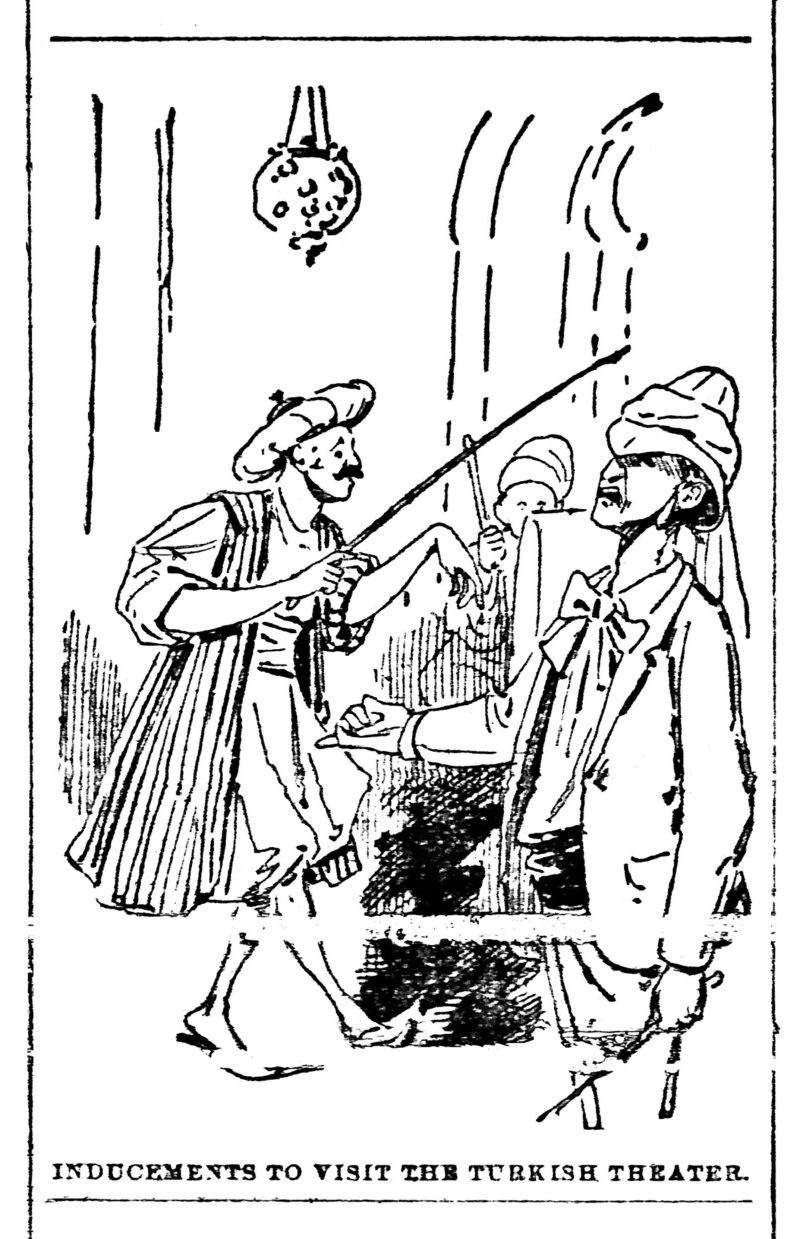
An illustration by W. W. Denslow for “Barkers at the Fair” in the July 30, 1893 issue of the Chicago Herald depicts “inducements to visit the Turkish Theater” from a spieler out front.
“I’m a Midway orator”
While W. O. Taylor and Jean DeKreko provide first-hand (though inconsistent) accounts linking the invention of ballyhoo to the 1893 Midway, their recollections were not recorded until years after the close of the Columbian Exposition.
Another first-hand account was published just four months after Chicago fair closed when many of the Midway concessions had moved to the 1894 Midwinter Exposition in San Francisco. A feature article on the Midway in Golden Gate Park published in the San Francisco Examiner included a brief interview with J. Will Halton of the Ostrich Farm attraction. Halton explains:
“I was the first to talk on the Midway in Chicago, where I took a band from Mexico. Before that I was a newspaper man. I’m not a barker. I’m a Midway orator. I don’t do any of this ballyhoo business with horns and gongs. I don’t require any of these aids to oratory. All I do is give a little instructive chat.”
This somewhat pejorative mention of ballyhoo business to refer to the loud barkers during the Columbian Exposition shows that the term was in use soon after the original Midway disbanded.
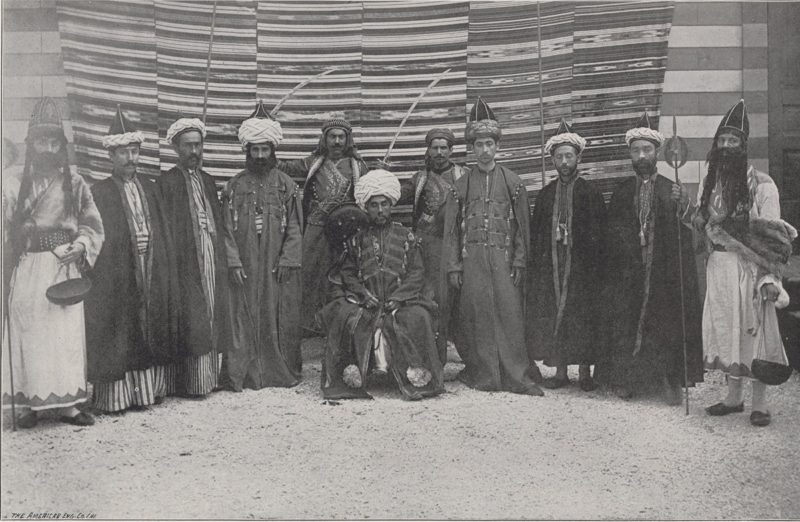
Some of the sixty-five performers from the Turkish Theatre on the Midway. [Image from Midway Types: A Book of Illustrated Lessons about The People of the Midway Plaisance (The American Engraving Company, 1894).]
Ballyhoo girls have grown too gay
Evidence of a slightly different usage of ballyhoo emerged around a controversy at the 1895 Cotton States and International Exposition in Atlanta. On November 20, the Exposition company announced that it was putting an end to alleged immorality of women bally-hoos working in front of the more sensational attractions on the Midway there. “These spielers and ballyhoo girls have grown too gay the last few days,” reported the Chicago Chronicle. As opposed to the 1893 Chicago fair, where complaints (and a short-lived injunction) against fakirs was for the volume of their oral solicitation, the action against ballyhoos in Atlanta two years later was focused on the appearance of these women, who were:
“… absolutely prohibited from displaying themselves to the public view in front of the Midway shows. The women have been used as advertising mediums by appearing in costumes conspicuous for their brevity, but from now on the attractive feminines will not be allowed to appear even should they dress in the most puritanical manner. The edict is against women, young old, new or coquettish, and against them it will be enforced.” [“Bally Hoos No More”]
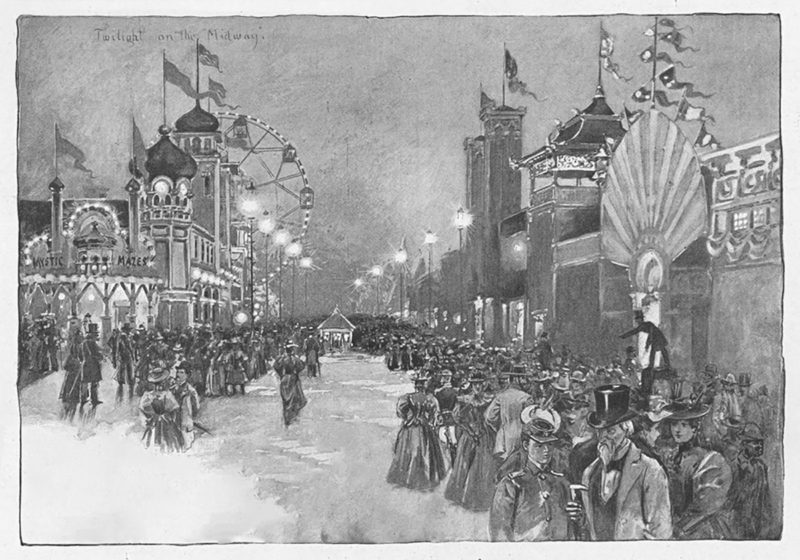
Scene of the Midway at the 1895 Cotton States and International Exposition in Atlanta, where spielers and “ballyhoo girls” got into some hot water. [Image from Harper’s Weekly Nov. 2, 1895.]
Uncertain origins
Named for a Chicago park that hosted the “bazar-of-all-nations” entertainment strip of the 1893 World’s Fair, midways became a fixture of American fairs and circuses. Carnival workers carried with them the term ballyhoo, which eventually integrated into the American language as a word for an “extravagant or brash publicity.”
Although the time and place of the birth of ballyhoo is missing from the OED, primary evidence from several sources indicates that this “carnival” usage of the word originated at the 1893 World’s Fair and was in general use on other midways soon after.
SOURCES
“B’ Allah Hoo” Motion Picture Herald Jan. 25, 1936, p. 61.
“ballyhoo, n.2”. OED Online. March 2021. Oxford University Press. https://www.oed.com (accessed April 25, 2021).
“Bally Hoos No More” Atlanta Constitution Nov. 20, 1895, p. 8.
McKennon, Joe. A Pictorial History of the American Carnival, Vol. 1. Carnival Publishers of Sarasota, 1972.
Mencken, H. L. The American Language: An Inquiry into the Development of English in the United States, 4th ed. Alfred A. Knopf, 1937, p. 188.
Nickell, Joe Secrets of the Sideshow. University of Kentucky Press, 2005.
Taylor, W. O. “How the Carnival Idea Was Born” Billboard Dec. 29, 1934, p. 178.
“Toungsters of the Midway” San Francisco Examiner Mar. 11, 1894, p. 13.
Wolverton, Charles “Ballyhoo” American Speech 10, 4 (Dec. 1935), pp. 289–291.

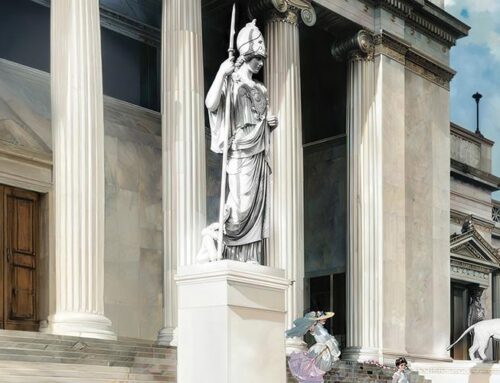
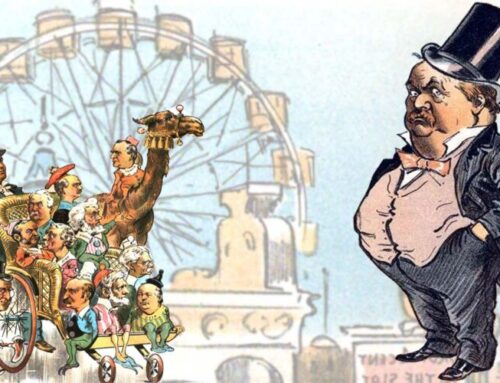
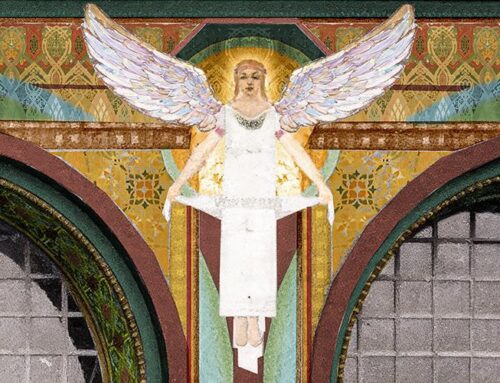
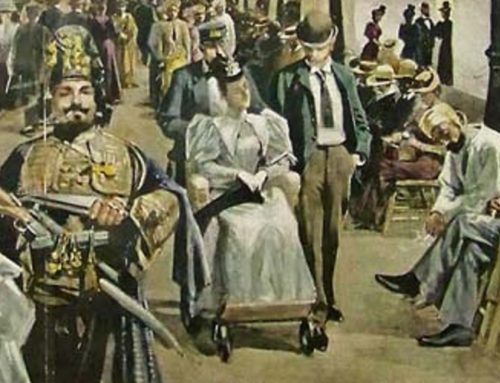

Leave A Comment